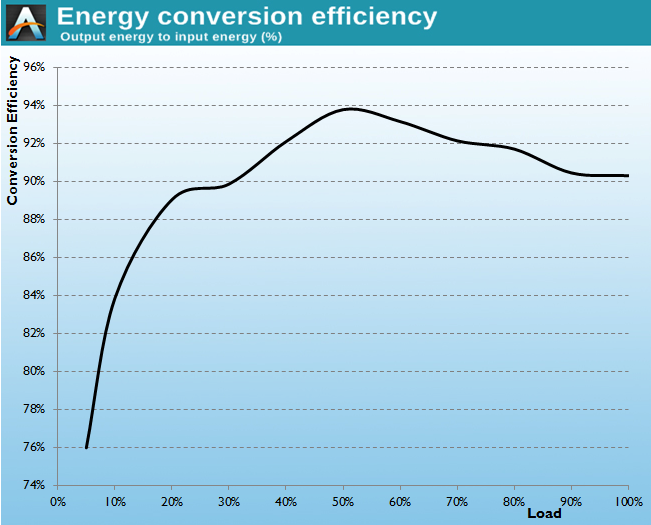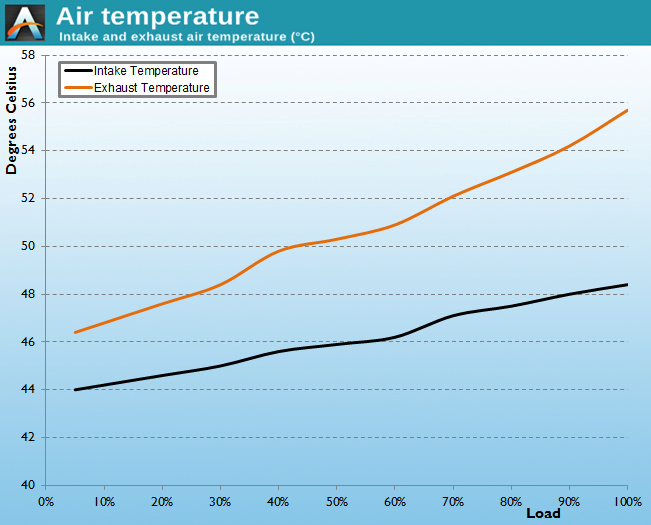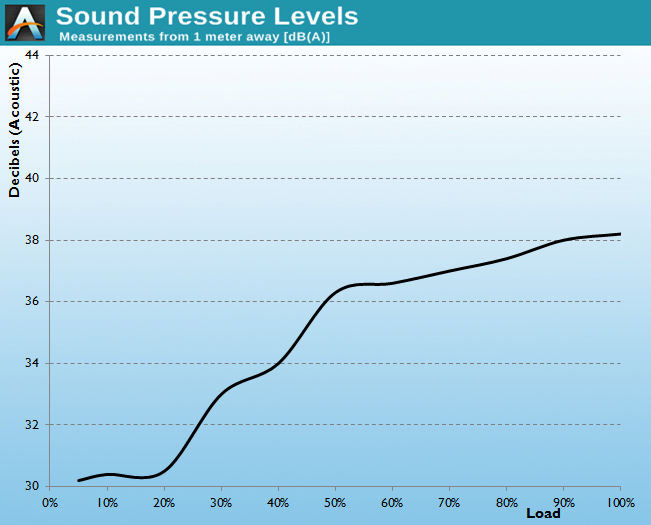Seasonic S12G 650W Power Supply Review
by E. Fylladitakis on February 28, 2014 2:20 PM EST- Posted in
- Cases/Cooling/PSUs
- Seasonic
- 80 Plus Gold
Hot Test Results
From the table below, it can be seen that the output power quality of the Seasonic S12G is very high. The maximum voltage ripple that our instrumentation recorded is a mere third of the ATX design guide suggested limit (the limits are 120 mV on the 12V line, 50 mV on the minor voltage lines), under full load and inside the hotbox no less. Cross-load testing negatively affects the power quality of any power supply but its effect on the Seasonic S12G is small, with the 12V line registering up to 54 mV while delivering 512W. Cross-load testing has virtually no effect on the minor voltage lines, the performance of which did not degrade any further than during standard testing.
| Line |
Regulation (20-100% load) |
Voltage Ripple (mV) | |||||
| 20% Load | 50% Load | 75% Load | 100% Load |
CL1 12V |
CL2 3.3V + 5V |
||
| 3.3V | 2.1% | 6 | 8 | 12 | 14 | 6 | 12 |
| 5V | 2.6% | 8 | 12 | 12 | 16 | 6 | 16 |
| 12V | 1.7% | 14 | 22 | 30 | 46 | 54 | 16 |
The impact that the higher ambient temperature has on the energy conversion efficiency is rather small, reducing the efficiency of the Seasonic S12G by about 0.5% across the entire load range. As such, the Seasonic S12G easily retains its 80 Plus Gold efficiency certification status even inside a very hot environment. The average efficiency between 20% and 100% load is an extremely high 91.6%.
The difference between our cold and hot tests is an increase of over 20°C ambient and, naturally, all of the temperature readings increase significantly. We dare say that the temperatures of the heatsinks rise quite a bit beyond our expectations of an 80 Plus Gold unit by Seasonic; however, the heatsinks are rather small and the design of the power supply apparently focuses on low-noise operation, so sacrifices are made in the area of temperatures.
The low-noise aptitude of the Seasonic S12G becomes apparent when we see that the fan hardly exceeds 38 dB(A) under the harshest of conditions, which is an audible figure but hardly louder than three or four 3.5" mechanical disks -- and never mind the GPUs that would be required to hit such loads. Nevertheless, unless you somehow manage to maintain the unit at maximum load inside a >50 °C environment, the Seasonic S12G will not get nearly hot enough to cause problems.














77 Comments
View All Comments
WoodyPWX - Friday, February 28, 2014 - link
Ordered, thanks!mark28 - Friday, February 28, 2014 - link
How's their fanless PSUs now? The last few I got had a really annoying constant buzzing sound.Sivar - Friday, February 28, 2014 - link
I returned two of them before I ordered a Rosewill SilentNight (same as Kingwin Stryker STR-500). I heard the new generations of Seasonic are almost always silent, but I'm happy with the SilentNight, too.stratum - Saturday, March 1, 2014 - link
I got a fanless Seasonic PSU last month and the constant buzz was more annoying than a PSU with a fan. Waste of money when my main reason for getting it was negated.motas - Saturday, March 1, 2014 - link
For my builds that rarely draw 250 W max, after how reliable the PSU is, the next thing I care most about is the noise. Not just dBA numbers but also how it sounds. You could look at the frequency spectrum and most of the sounds people would find more annoying would show a pattern. A fan putting out 30 dBA could sound "worse" than one at 35 dBA. Last I care about is efficiency. As long as the PSU can reliably provide the requested power then I'm good. I'm not runing servers or crypto miners at constant load 24/7.E.Fyll - Saturday, March 1, 2014 - link
"A" in "dB(A)" stands for "acoustic", i.e. it is within the part of the dB range that your ears can perceive. You are actually right that a fan rated at 30 dB(A) can actually sound worse than a fan rated at 35 dB(A), but that's because these readings/ratings are being taken inside anechoic chambers. It is possible that due to vibrations or simply because of the frequency the sound is emitted at (reflections, echo, etc), the first fan could actually sound worse than the second fan inside a real room; but the instruments would read that as well. We are doing noise testing inside a real room so that is as close to reality as it gets.I understand that some "types" of noise might be more bothersome than others to some people, but that is relative and mostly psychological; I cannot possibly assess that quantifiably.
morso - Saturday, March 1, 2014 - link
How about provide a frequency spectrum plot. You know, white noise vs colored noise. People can then decide for themselves if the sound is good or not.g.davis - Saturday, March 1, 2014 - link
If that's not possible then maybe record the sound and post an audio file. Hopefully, the recording process can be standardized. That buzzing sound from a fanless Seasonic PSU was extremely annoying especially for a bedroom PC that doesn't get turned off. I'd rather get a louder PSU with a fan. Which I did.E.Fyll - Saturday, March 1, 2014 - link
You actually suggested inserting a graph with spectral profiles in a review?People cannot decide "if the sound is good or not" by looking at such a graph, not only because it will not tell you anything of actual relevance but because, well, they cannot read it. Aside the fact that only a handful people can actually read such a graph, do you realize the kind of equipment that is required to generate it? Space aside, we are talking about hundreds of thousands of dollars.
This is absolutely out of the question, sorry.
tosisgray - Saturday, March 1, 2014 - link
Why not provide an audio recording. Sometimes it's the subjective parts people care about most. With your statement, it seems you're not targeting professiosnals anyway. Efficiency doesn't matter much to the crowd you seem to be targeting unless the vendor is falsely advertising their product. These PSUs will likely go inside homes. Maybe bedrooms and living rooms.